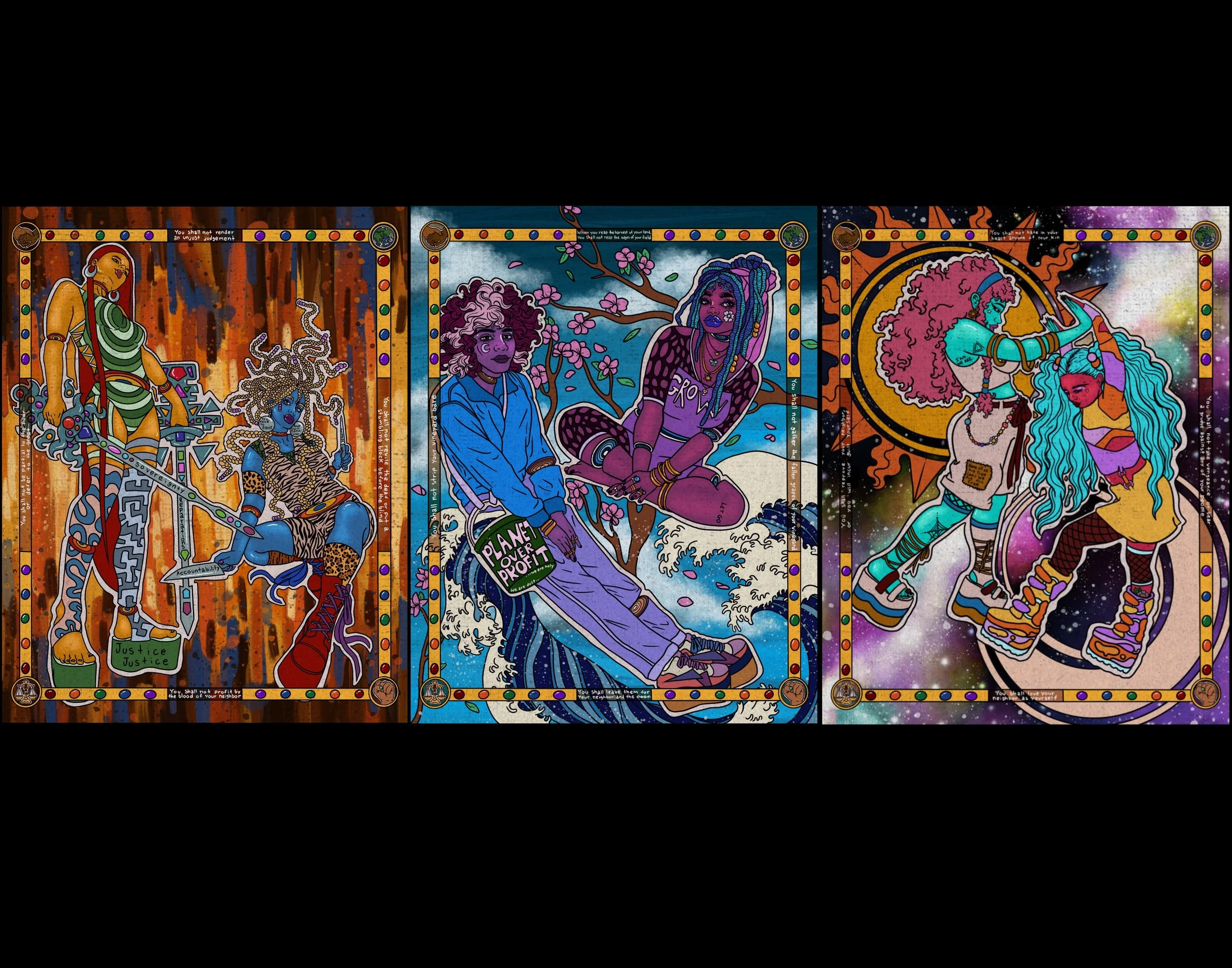פרשת קדושים Parshat Kedoshim
Ayeola Omolara Kaplan and Rabbi Michael Rothbaum
Summary and Video Link:
In this articulation, we are presented with a deconstruction of our core societal values into the themes of Love, Justice and our Planet. Through the exploration of 12 poignant passages guided by the observations and insights of Ayeola Omolara Kaplan and Rabbi Mike Rothbaum.
To watch the recording of their Articulation please follow this link here
Piece Description:
Ayeola Omolara Kaplan - Love, Earth, Justice 2022
In this triptych inspired by Kedoshim, I highlight three essential elements in creating a holy society. These three elements are love, justice and a reverence for the earth we live on. In Kedoshim we find incredible truths and calls to action which still hold great relevance today. Kedoshim holds space for our need for justice, while admonishing us against vengeance. We are encouraged to treat strangers as we would treat our kin, to look after the poor, and to have an economy that puts people over profit. These paintings celebrate the multitude within Jewishness and our holy pursuit of awakening the sacred within the mundane.
Discussion Questions:
1. Each image of the Tryptich features two figures. Why do you think each topic engages two figures and what differences do you notice between how they interact with one another in “Love”, “Earth” and “Justice”?
2. There are many phrases sprinkled throughout these pieces. What is one phrase that resonates with you? What draws you to this idea? What examples from your life does it remind you of?
3. In “Justice” and “Earth” the figures have been dismembered, but this is not the case for “Love”. Why do you think Ayeola chose to distinguish “Love” from the other two? What do you think the dismemberment represents?
4. Though these images are replete with many intricate details, their single word titles contrast this business and leave much room for the imagination to fill in personal. Do these three images correspond to your understanding of “Love”, “Earth” and “Justice”? What aspects of these works ground the meaning of these three concepts and which extend to the expansiveness of its many possible interpretations? In which ways were your expectations subverted?
Parshat Kedoshim קדושים
by Rabbi Mike Rothbaum
What does God want of us?
Reading this on the page, you might recoil from the inquiry. Who even asks such a thing? Religious fanatics on street corners, maybe. Sweaty-browed TV preachers. It seems untoward. Tasteless even.
What does God want of me?
Sorry — who’s asking? But for any of us who would presume to have a connection, in any way, to a “higher power,” the question is relevant. If we believe that there is some force that is invested in the fate of creation, then the question must always demand a response: what’s our task in that creation?This week’s parashah, Kedoshim, provides a compelling Jewish answer. Kedoshim t’hiyu, God tells Moses to instruct the Israelites. “You should all be holy.” You might wonder why. The text provides an answer. Ki Kadosh Ani. “Because,” says God, “I’m holy.” (Leviticus 19:2) Make yourselves holy by making yourself Godlike.These simple teachings represent essential elements of Judaism’s revolutionary worldview. Human beings, though earthbound, are capable of reaching sublime heights.That we can do so is remarkable. How we can do so is, perhaps, even more so. For the holiness of Kedoshim is not reserved for the select few, mystics ensconced in meditation. Holiness “does not mean the hermit’s holiness, isolation and seclusion as a means of seeking the holy way,” writes 18th century German Rabbi Moses Schreiber, in his Torah commentary, Chatam Sofer. “On the contrary, what is spoken of is the holiness of the community, a holiness that springs precisely from being within a community, a congregation, mingling with other human beings.”
Indeed, God commands Moses to speak to kol-eidat, the entire community, regarding what is holy (Leviticus 19:2). This insistence that every one of us participate in holiness-making is an essential element of Jewish theology.Thus, the bulk of the teachings in Kedoshim involve how we construct society, and how we interact with each other in that society. These are not just guidelines or “best practices.” Kedoshim talks about holiness, and these obligations too are holy obligations.
Many of the instructions involve imbalances of power. Kedoshim enumerates laws regarding relatively weaker groups: the elderly, consumers, immigrants, workers. Those who have accrued power through land ownership, for example, must leave some of their produce for those who are poor and landless. Those who have the power to hire and fire employees are warned not to oppress their workers. For those empowered as judges, stealing, lying and false denials are forbidden, as is the avel b’mishpat, the “violent injustice” of discrimination (Leviticus 19:15).
That exact phrase, avel b’mishpat, appears twenty verses later, in which sellers are instructed not to do injustice in middah, the weights and measures they use in commerce and trade (Leviticus 19:35). The connection is clear: if you cheat your customers in your business, it is oppression. “Have honest measures,” the text continues, because I am the God Who “brought you out from the land of Egypt.”
In other words, God seems to be saying, “I didn’t bring you out of slavery just so you could enslave each other.” To oppress a customer, an employee, a tenant, is to act as a mini-Pharaoh — and, by extension, to deny and desecrate the Name of the God Who freed us from Pharaoh, releasing us from bondage for the purpose of establishing holiness.
We are accustomed to references to holy objects and places, our “Holy Torah” and our “Holy Land.” But the parashah we call Kedoshim, outlining the path to holiness, is concerned with what we might call “Holy Economy”.
The power of “Holy Economy” is that we don’t need to be in any place or moment to enact it. Outside the shul, outside the Holy Land, physically removed from a Torah scroll or teachers of Torah, we can live this holiness.
Of course, in a way, it’s harder. There are clear, generally agreed-upon, guidelines for how to treat a Torah scroll. How a “Holy Economy” might manifest itself in today’s world is trickier. If individual sellers have the power of personal judges charged with observing mishpat and tzedek, what of the corporate seller, and its loyal servant, the advertiser? If the individual has the power of a judge, how much more so the large corporate body with electronic and print media at its disposal? What is the responsibility of the individual working in such a firm? Where do we find the wisdom to elaborate the details of these principles? How are these regulations to be policed, and by whom?
We make policy prescription on behalf of God at our own peril. And yet, Parashat Kedoshim offers a blueprint for a holiness platform, an invitation to collaborate with a God desperately searching for willing human partners in the sacred task of creating a world that celebrates the glory of every soul, each one a reflection of the Divine.
The murky path of navigating the details can’t deter us from this holy project. The verse that instructs us to spurn corruption in justice continues: “don’t lift up the face of the poor or glorify the face of the rich.” (Leviticus 19:15) At first blush we might ask: In a land where the playing-field is chronically tilted in favor of the rich, why not lift up the face of the poor?
The promise of a “Holy Economy” is that the poor won’t need the grand gestures of the well-off — because we’ll all be walking a path of justice and wholeness.




